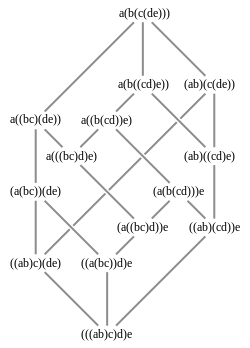Tamari lattice
In mathematics, a Tamari lattice, introduced by Dov Tamari (1962), is a partially ordered set in which the elements consist of different ways of grouping a sequence of objects into pairs using parentheses; for instance, for a sequence of four objects abcd, the five possible groupings are ((ab)c)d, (ab)(cd), (a(bc))d, a((bc)d), and a(b(cd)). Each grouping describes a different order in which the objects may be combined by a binary operation; in the Tamari lattice, one grouping is ordered before another if the second grouping may be obtained from the first by only rightward applications of the associative law (xy)z = x(yz). For instance, applying this law with x = a, y = bc, and z = d gives the expansion (a(bc))d = a((bc)d), so in the ordering of the Tamari lattice (a(bc))d ≤ a((bc)d).

In this partial order, any two groupings g1 and g2 have a greatest common predecessor, the meet g1 ∧ g2, and a least common successor, the join g1 ∨ g2. Thus, the Tamari lattice has the structure of a lattice. The Hasse diagram of this lattice is isomorphic to the graph of vertices and edges of an associahedron. The number of elements in a Tamari lattice for a sequence of n + 1 objects is the nth Catalan number Cn.
The Tamari lattice can also be described in several other equivalent ways:
- It is the poset of sequences of n integers a1, ..., an, ordered coordinatewise, such that i ≤ ai ≤ n and if i ≤ j ≤ ai then aj ≤ ai (Huang & Tamari 1972).
- It is the poset of binary trees with n leaves, ordered by tree rotation operations.
- It is the poset of ordered forests, in which one forest is earlier than another in the partial order if, for every j, the jth node in a preorder traversal of the first forest has at least as many descendants as the jth node in a preorder traversal of the second forest (Knuth 2005).
- It is the poset of triangulations of a convex n-gon, ordered by flip operations that substitute one diagonal of the polygon for another.
Notation
The Tamari lattice of the Cn groupings of n+1 objects is called Tn, but the corresponding associahedron is called Kn+1.
In The Art of Computer Programming T4 is called the Tamari lattice of order 4 and its Hasse diagram K5 the associahedron of order 4.
References
- Chapoton, F. (2005), "Sur le nombre d'intervalles dans les treillis de Tamari", Séminaire Lotharingien de Combinatoire (in French), 55 (55): 2368, arXiv:math/0602368, Bibcode:2006math......2368C, MR 2264942.
- Csar, Sebastian A.; Sengupta, Rik; Suksompong, Warut (2014), "On a Subposet of the Tamari Lattice", Order, 31 (3): 337–363, arXiv:1108.5690, doi:10.1007/s11083-013-9305-5, MR 3265974.
- Early, Edward (2004), "Chain lengths in the Tamari lattice", Annals of Combinatorics, 8 (1): 37–43, doi:10.1007/s00026-004-0203-9, MR 2061375.
- Friedman, Haya; Tamari, Dov (1967), "Problèmes d'associativité: Une structure de treillis finis induite par une loi demi-associative", Journal of Combinatorial Theory (in French), 2 (3): 215–242, doi:10.1016/S0021-9800(67)80024-3, MR 0238984.
- Geyer, Winfried (1994), "On Tamari lattices", Discrete Mathematics, 133 (1–3): 99–122, doi:10.1016/0012-365X(94)90019-1, MR 1298967.
- Huang, Samuel; Tamari, Dov (1972), "Problems of associativity: A simple proof for the lattice property of systems ordered by a semi-associative law", Journal of Combinatorial Theory, Series A, 13: 7–13, doi:10.1016/0097-3165(72)90003-9, MR 0306064.
- Knuth, Donald E. (2005), "Draft of Section 7.2.1.6: Generating All Trees", The Art of Computer Programming, IV, p. 34.
- Tamari, Dov (1962), "The algebra of bracketings and their enumeration", Nieuw Archief voor Wiskunde, Ser. 3, 10: 131–146, MR 0146227.